Fall garden – when to plant for color-filled pots, beds and borders
Discover when to plant a fall garden and create a yard that’s full of color, texture and interest
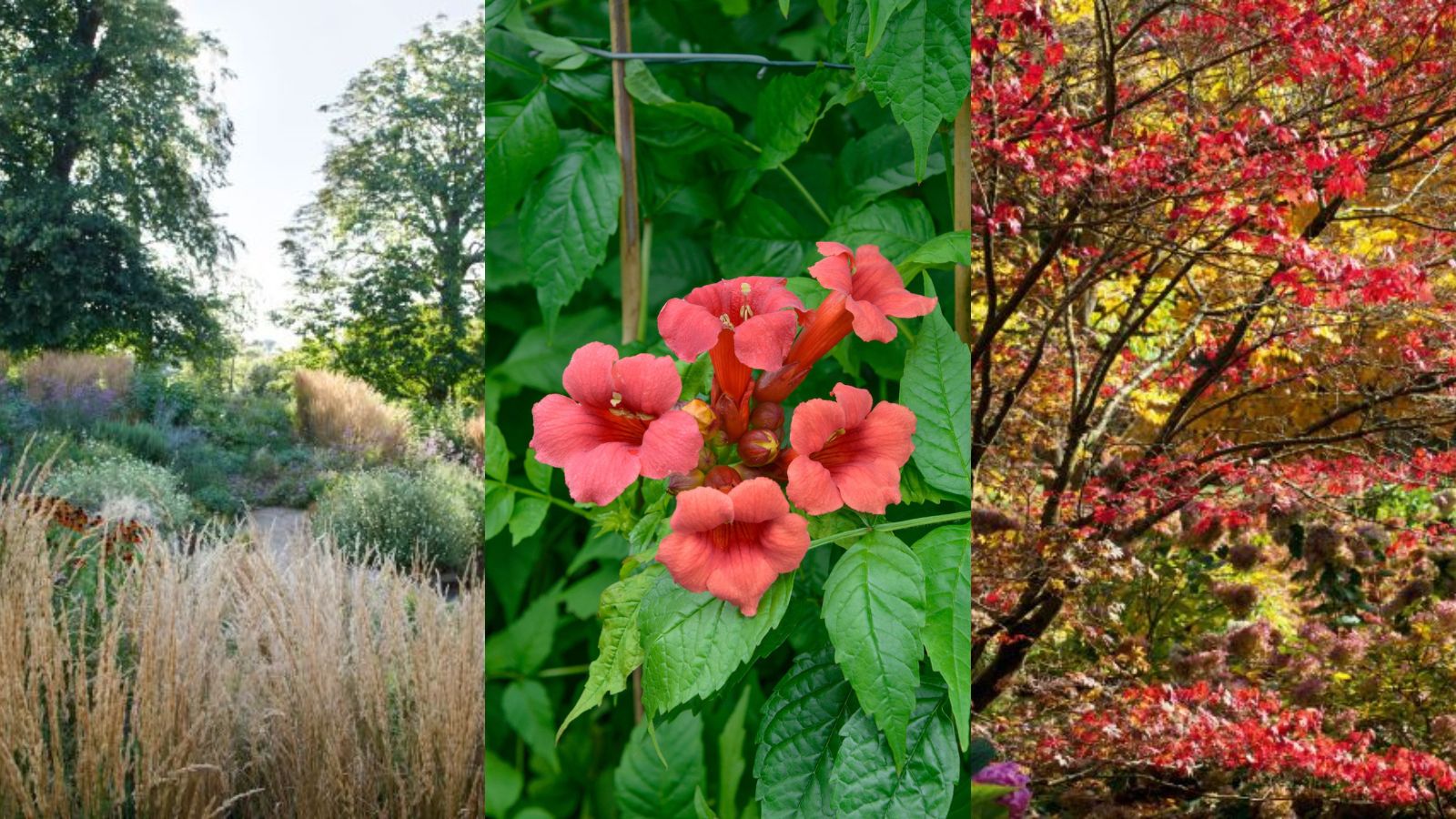

Knowing when to plant a fall garden, and with a little planning, you can continue the color show right through to the end of the year. This is vital if you are all too aware that your yard reaches its floral best during spring and summer only to fade away in fall.
There are many shrubs, trees and plants that put on a breath-takingly colorful autumn show. From the best fall trees, such as standout Japanese acers in their vivid shades of red, orange and purple, through to fall flowers for pots, such as flamboyant dahlias and more subtle but no-less beautiful, ornamental grasses you can find late season stars for every area of your yard.
Fall planter ideas and plants for hanging baskets also play an important role at this time of year. Replace fading late summer flowers with sculptural evergreens such as box, bay and laurel and berry laden favorites including ghostly snowberry, skimmia, hypericum and callicarpa with its bold purple fruits. Fall flowering bulbs add striking notes of color – cyclamen, colchium and nerines being just three to mention while many climbing plants also come into their own dazzling with glowing leaves, fruits and flowers.
All have different requirements, but this guide to when to plant a fall garden will help you set a schedule.
When to plant a fall garden
Just because the days are growing shorter and the weather cooling, it doesn’t mean our gardens have to be any less inspiring. Learn when to plant a fall garden so you can plan ahead and make confident choices of plants for fall color with spectacular results.
Planting trees in fall
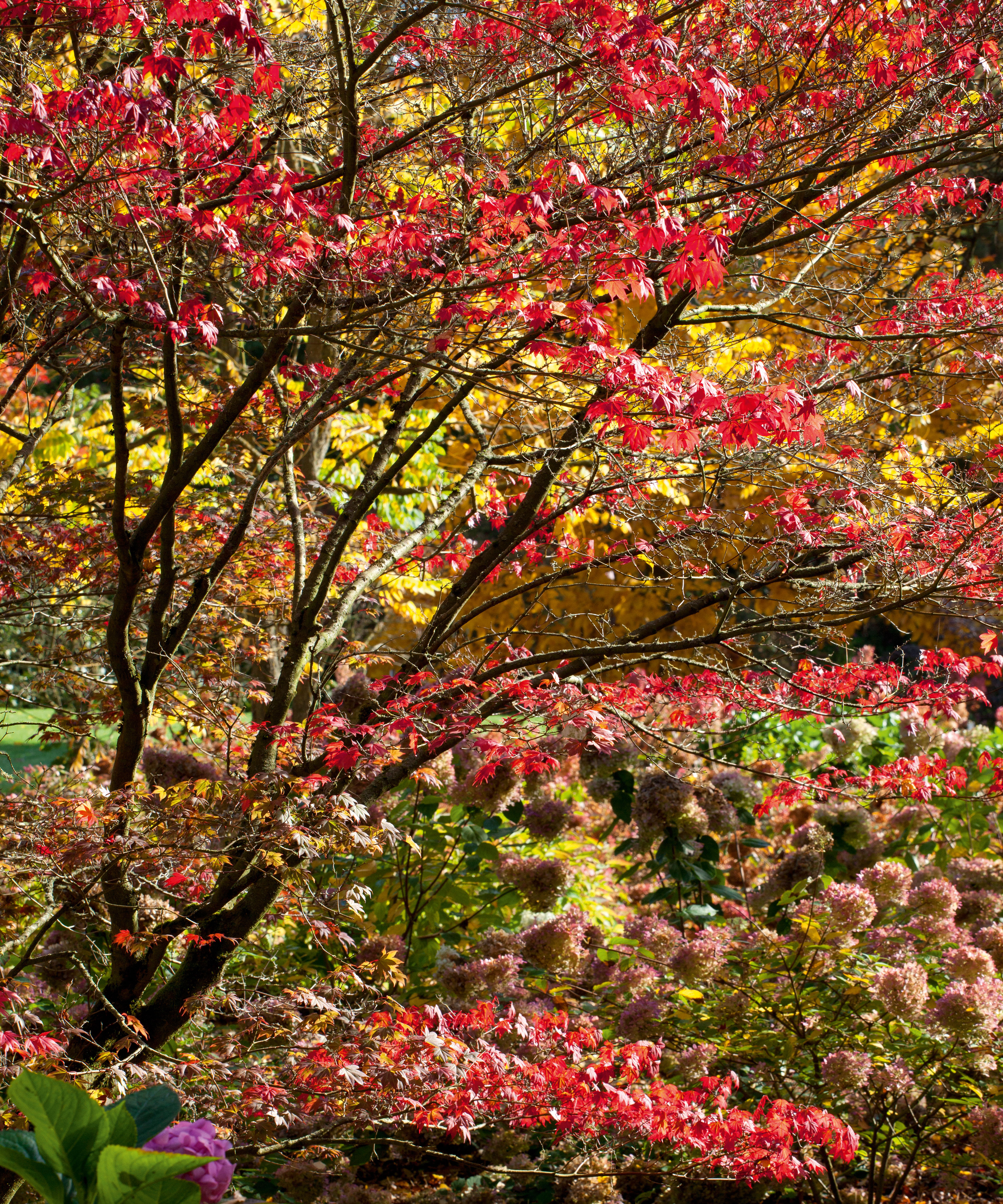
Adding height, stature, color and texture to any yard, native and ornamental trees will always make an impact but particularly in fall. It could be for their vivid leaf color, rich textured bark or even their ripening fruit or perhaps for the opposite reason – the shape and structure an evergreen variety offers when everything else around it begins to soften and fade.
With so many different choices to make it is crucial to choose a variety of tree that is appropriate to your plot, climate and needs. Emily Olson Senior Manager at American Forests says, ‘You might want to consider planting a tree species that is native to your general region, rather than a species from Asia, Europe or from the other side of the United States. Native trees are adapted to local conditions and provide essential habitat and food for wildlife like birds and butterflies. You can use a tool like the Audubon Native Plant Database to look up trees that are native to your area.’
When to plant a tree in the ground is a matter of some debate. Depending on your HDSA hardiness zone, the best times are either spring or fall. Planting a tree just as the soil and weather gets warmer will encourage the plant to develop healthy roots but as deciduous varieties also need to grow new leaves simultaneously this can lead to stress and reduced growth, especially if the weather is unusually hot, dry or unexpectedly cold.
Planting trees in fall has the benefit of roots establishing in warm and usually moist soil but only until the ground freezes. Therefore, it really depends on the local climate, the plants final position and how much preparation, care and water you can provide.
Trees for pots offer more flexibility. As long as the air temperature is above freezing and the soil not waterlogged, the plants should be happy. Take time to read up on your chosen variety, the type of compost and position it requires plus its drainage needs to ensure you give it the best possible start.
Planting shrubs in fall
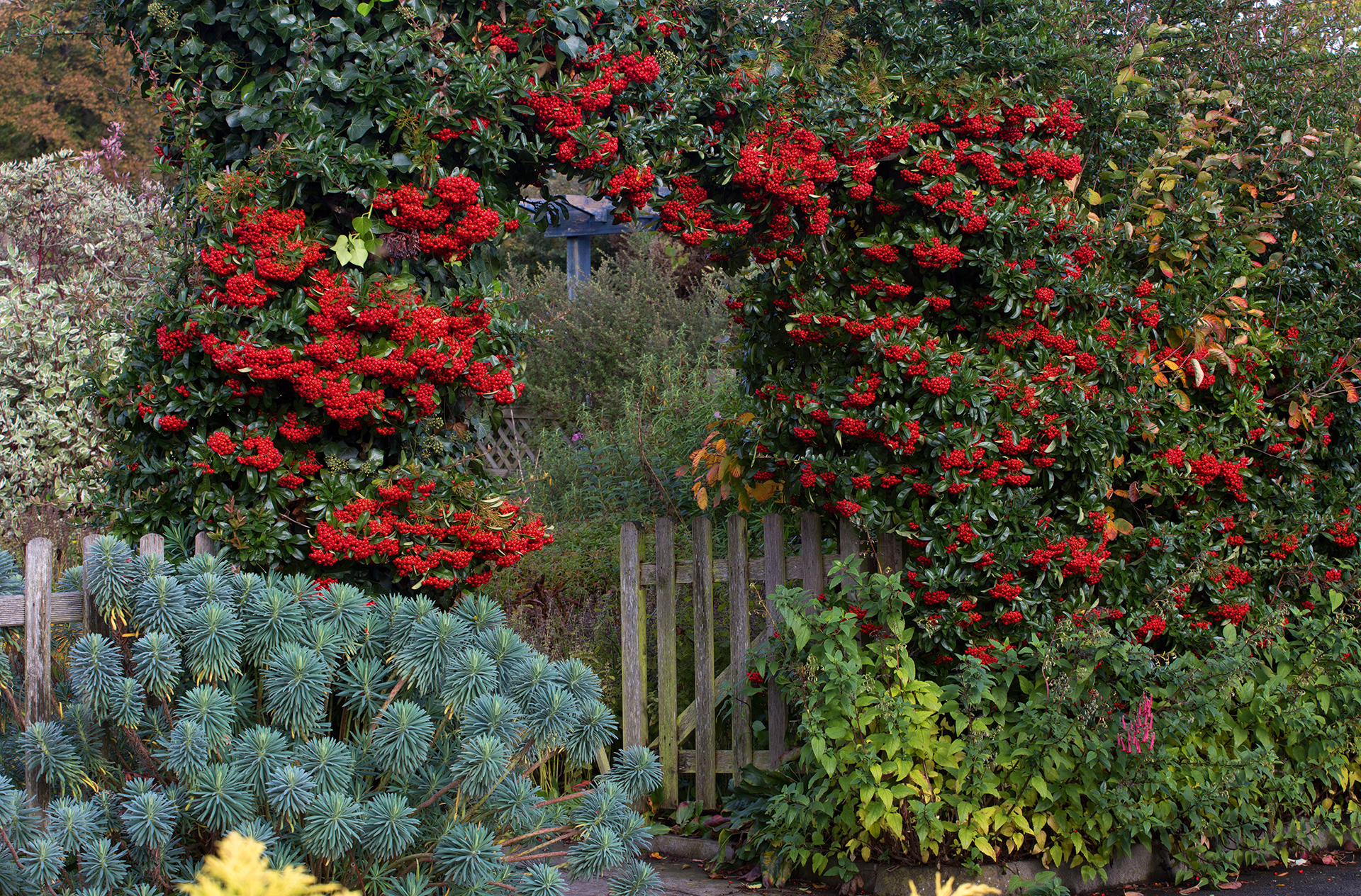
Playing a large role in any garden, shrubs provide a varied backdrop, and many come into their own in fall. From osmanthus with their small white sweetly scented blooms that appear in October, to elegant euonymus with its fiery foliage and pyracantha (above) with its clusters of bright orange red berries they always add an extra dimension to any bed or border and often are of huge benefits to pollinators and wildlife too.
Knowing exactly when to add a shrub to your plot does depend on the area and climate you live in, but as a general rule, Stefan German from Direct Native Plants says, ‘The best time to plant any plant is during the dormant season – in North America, this is usually late fall through early spring. While it’s okay to plant during the rest of the year, it will require more maintenance from you in the form of watering, fertilizers, etc. You can plant in the hot, dry summer but fall is really a great time to plant large shrubs, as they bulk up their existing root systems over winter, letting them drink more water.’
Planting annuals in fall
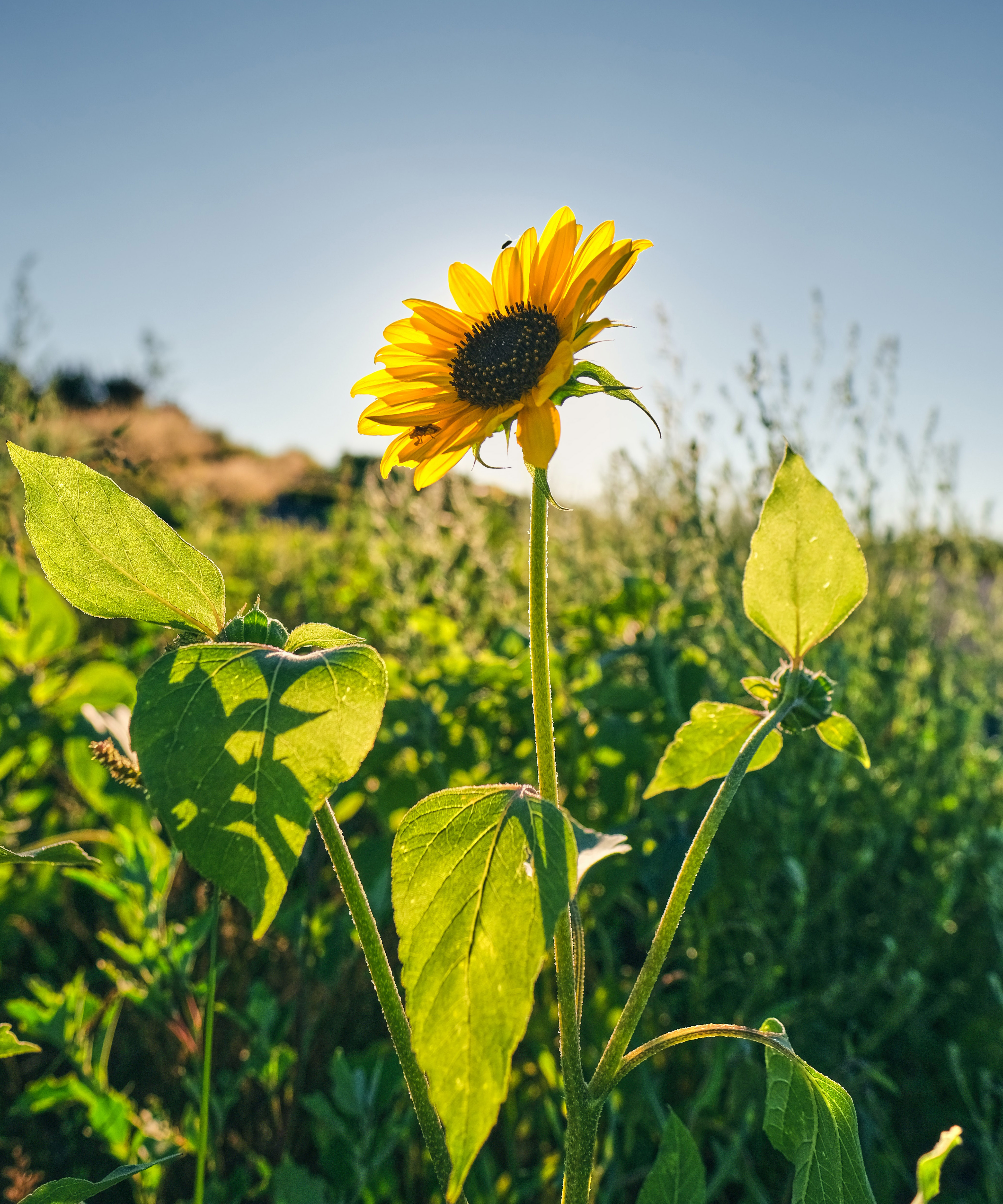
Bold, brilliant but short lived, annuals are valuable as seasonal mood-lifters at any time of year. Affordable and ideal for injecting vibrant color into pots, window boxes and hanging baskets they can play an important role in the fall garden.
‘Annuals can be a great way to fill gaps in borders left when the earlier varieties have gone over,’ says garden designer Rebecca Smith. ‘I am a big fan of growing sunflowers in all shapes and sizes, Claret and Ruby Sunset are two of my favorites.’
Cheery pansies and violas, flamboyant croton with its stripy leaves and unmistakeable flowering kale are other notable choices.
Depending on the time and space you have available, annuals can either be raised from seed started off in spring or bought from nurseries and retailers during summer and fall for immediate planting.
Planting perennials in fall

Garden beauties that reappear and bloom year after year, perennials are perhaps the staple of any backyard. Although each plant type has its own flowering habits and timings there are many that come into their own during fall.
Tom Brown, Head Gardener of West Dean Gardens says, ‘the daisy family has a cast of performers ready to take up the mantle and bring the house down with a riot of color.
'Rudbeckia ‘Goldsturm’ is hard to beat, requires no staking and will flower for weeks and weeks. Tithonia ‘Torch’ or the Mexican sunflower with its bright, zesty orange flowers packs a punch at the back of a border and is grown from seed each year. Also have a look at heleniums, solidagos and crocosmias (above) for fiery additions to your plantings.’
These backyard stalwarts can be planted anytime during the warmer weather, although spring and fall provide the benefit of warm soil and sun without the threat of extreme heat, which can stress and weaken the plant. Every new plant will require regular watering while it gets established, but providing it is ideally sited it they should need minimal attention long term.
Planting ornamental grasses in fall
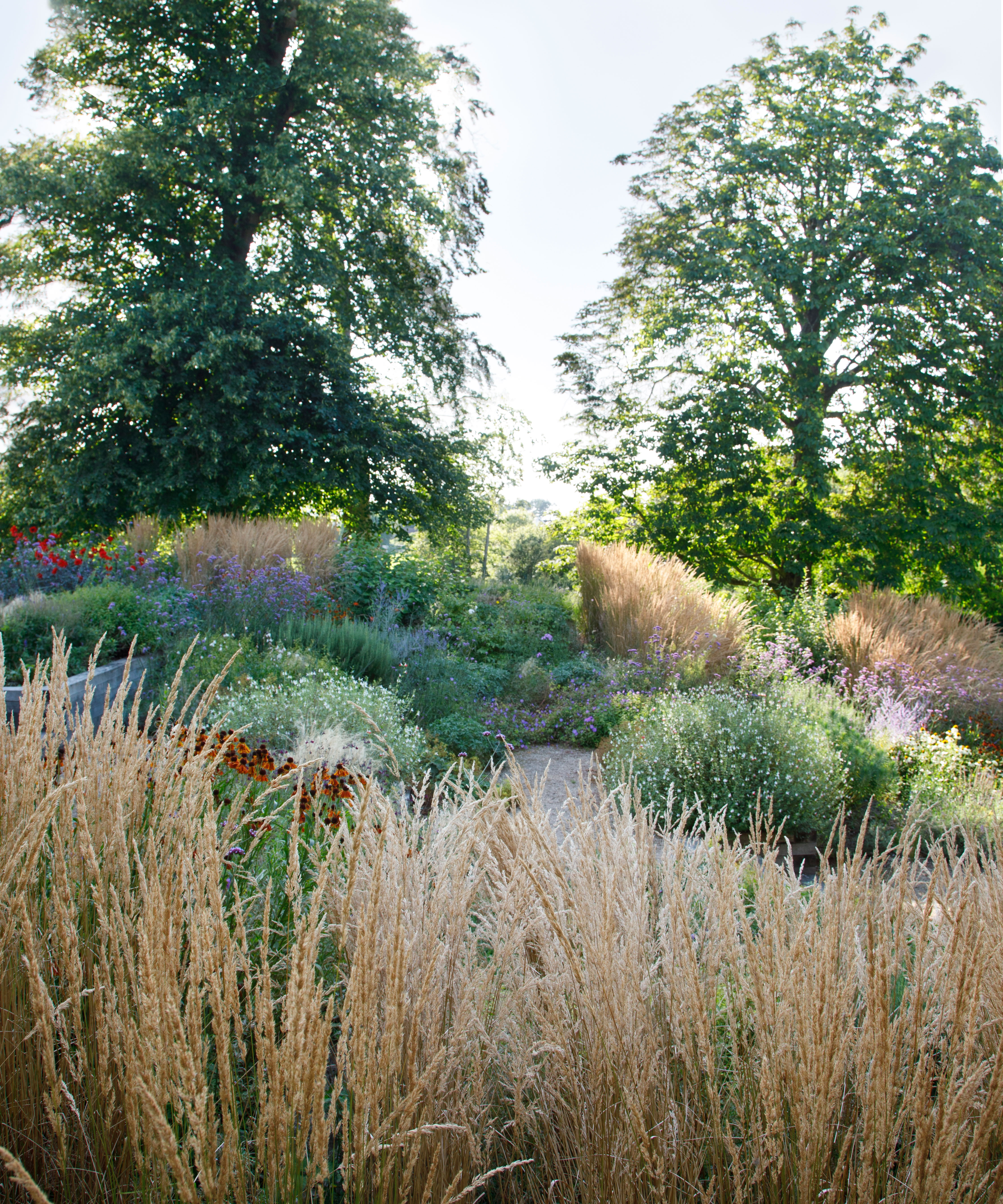
On trend and hugely popular, ornamental grasses may not be most people’s first choice when it comes to planting a fall garden. Tactile, distinctive and offering calming movement and sound they suit most sunny, well-draining spots and offer a beautiful palette of soft purples, parchment and deep russets.
‘The silvery plumes of Stipa pseudoichu and strong vertical shapes of Calamagrostis x acutiflora ‘Karl Foerster’ make excellent companions for late flowering perennials such as hylotelephium, rudbeckia and asters, offering interest well into fall,’ says Åsa Gregers-Warg Head Gardener at Beth Chatto’s renowned UK garden.
‘For sumptuous, architectural foliage, nothing beats Melianthus major with its grey-green, exotic looking leaves.’
Plant experts at the RHS advise that fall is the best time to plant grasses such as deschampsia, fescue and stipa. Originating from cooler climates they start growing in late winter and flower before mid-summer. Grasses that come from warmer climes tend to start their growing period later in spring and flower mid-summer to early fall, so are therefore better planted in late spring.
Planting climbers in fall
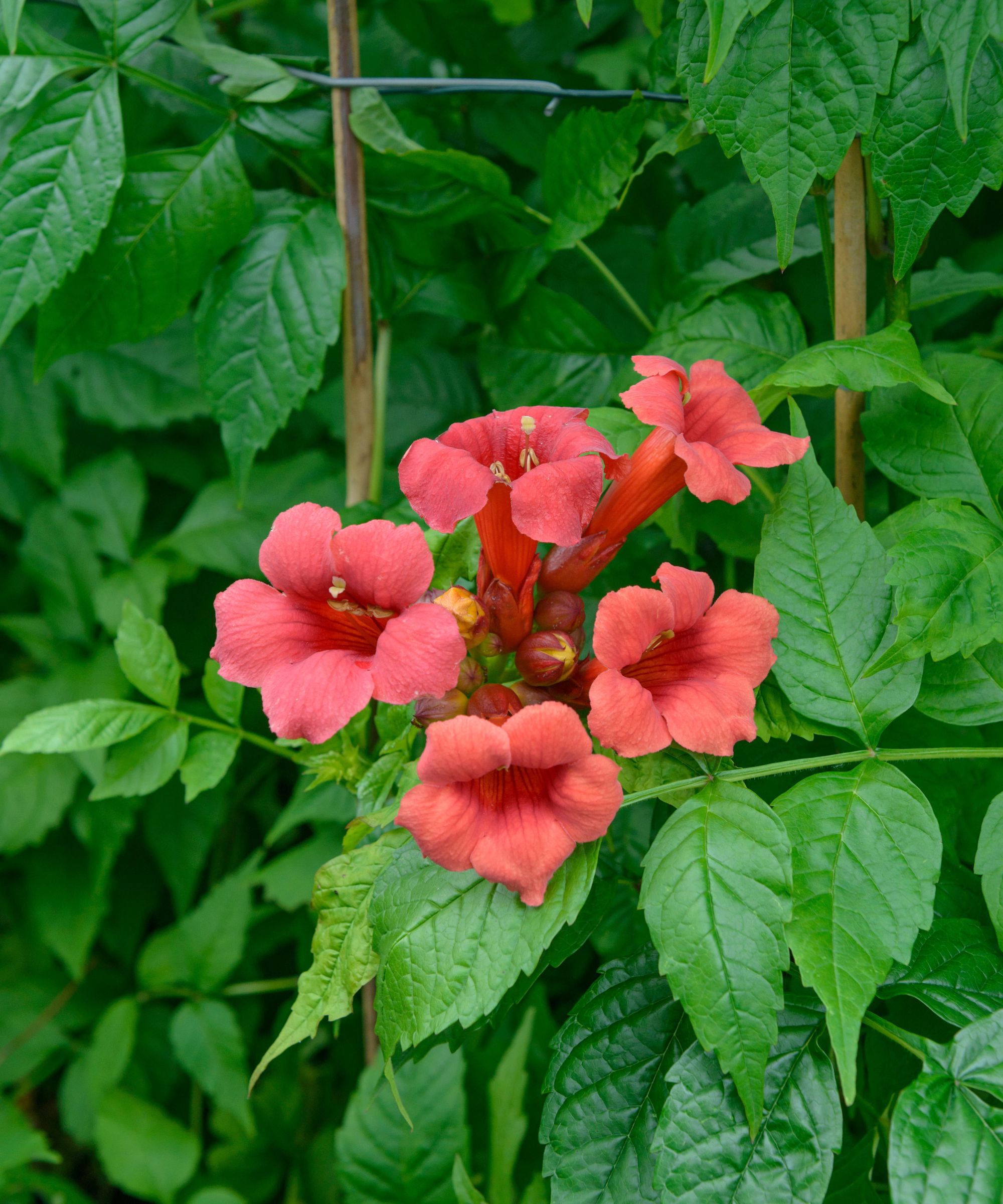
Whether you are looking to cover a wall, outbuilding or obelisk there are many climbing plants that put on a brilliant fall display. From dazzling, rich toned foliage to delicate blooms and vivid fruits, there are plenty of plants to choose from.
‘Always a challenge late summer and winter to fill the garden with flower but the Clematis species are great for this,’ says Chris Cocks of Taylors Clematis. ‘Starting to flower in July and the going all the way through to October, they have masses of small trumpet (or tulip or flute) shaped flowers in nice pink tones. Princess Diana, Princess Kate and more recently Prince William are great examples. They are easy to grow in sun or part shade aspects.’
Belonging to the third class of clematis they thrive in hardy zones 4-8.
Other fantastic options include fast-growing and indestructible Golden hop, which flowers in October, the buttery-yellow leaved Trumpet vine (above) with its orange blooms and, of course, the iconic Boston ivy with its self-clinging deep scarlet leaves. Plant climbers any time in the growing season, between the last and first frosts, but do avoid extreme heat and drought to avoid stressing the plants.
Planting hedging in fall
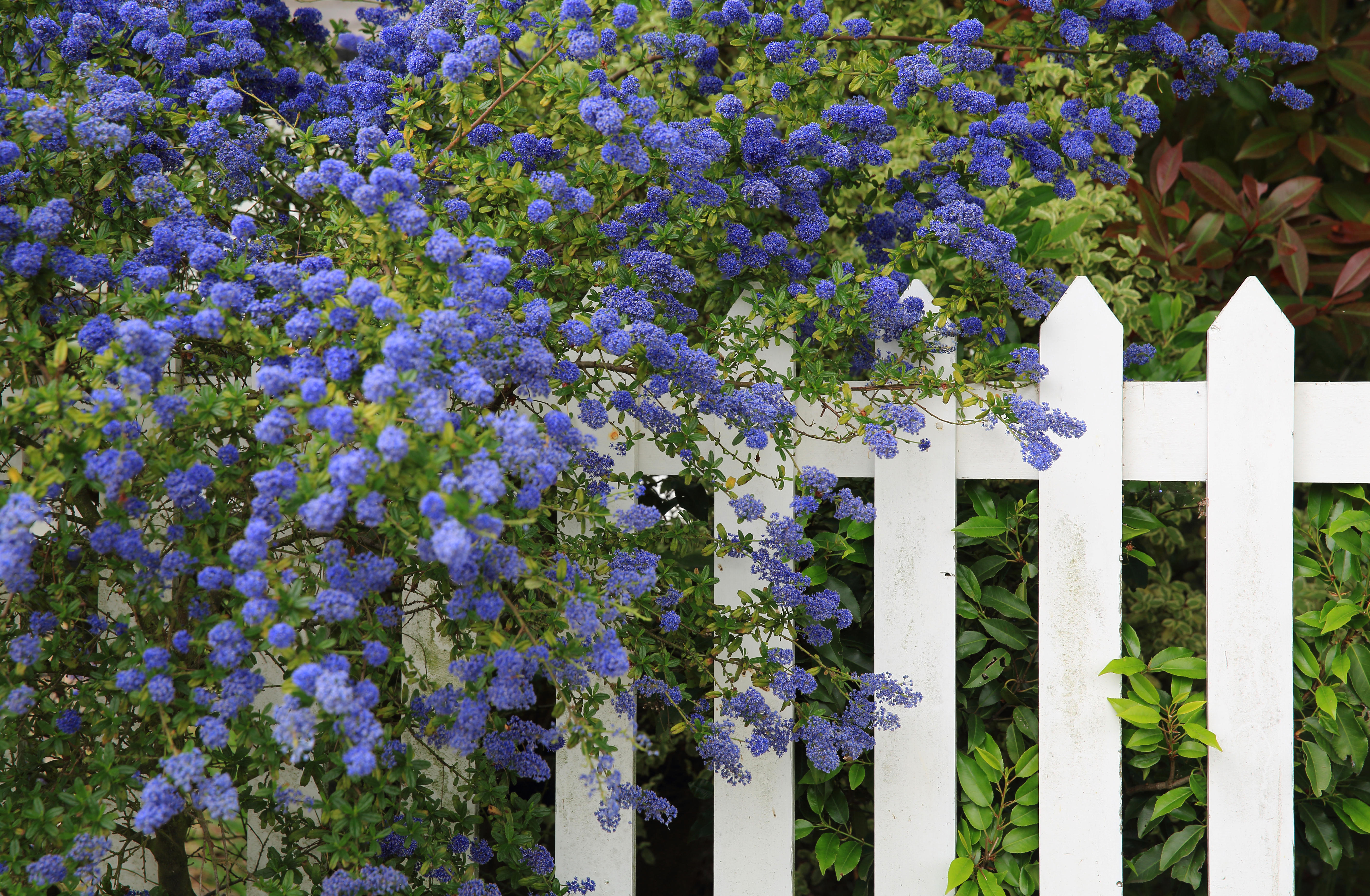
Looking to establish a hedge – then choosing the right planting time is almost as important as the plant variety you go for. Most hedge plants are best planted whilst dormant so anytime from fall through spring, as long as the ground is not frozen. Keep plants well watered for the first year or two, while the roots are establishing and especially during hot spells.
Hedging plants that provide dramatic fall color include Californian lilac (above), purple and green beech, dogwoods and euonymus also know as ‘burning bush’ for its glossy green turning deep burgundy foliage.
Besides providing security, noise reduction and screening, the best privacy hedges create a valuable habitat for birds and wildlife, too. Providing important shelter, food and nesting sites they also support biodiversity creating a spot for the tiniest insects through to small mammals such as mice, voles, stoats and foxes. Growing a mixed species hedge in your yard is a great way to broaden the appeal.
Choose both fast-growing hedges, and evergreen and deciduous plant species that are native to your area and be sure to encourage climbers such as dog roses, clematis and honeysuckle to weave through and provide extra seasonal color and interest.
Planting evergreen shrubs and trees
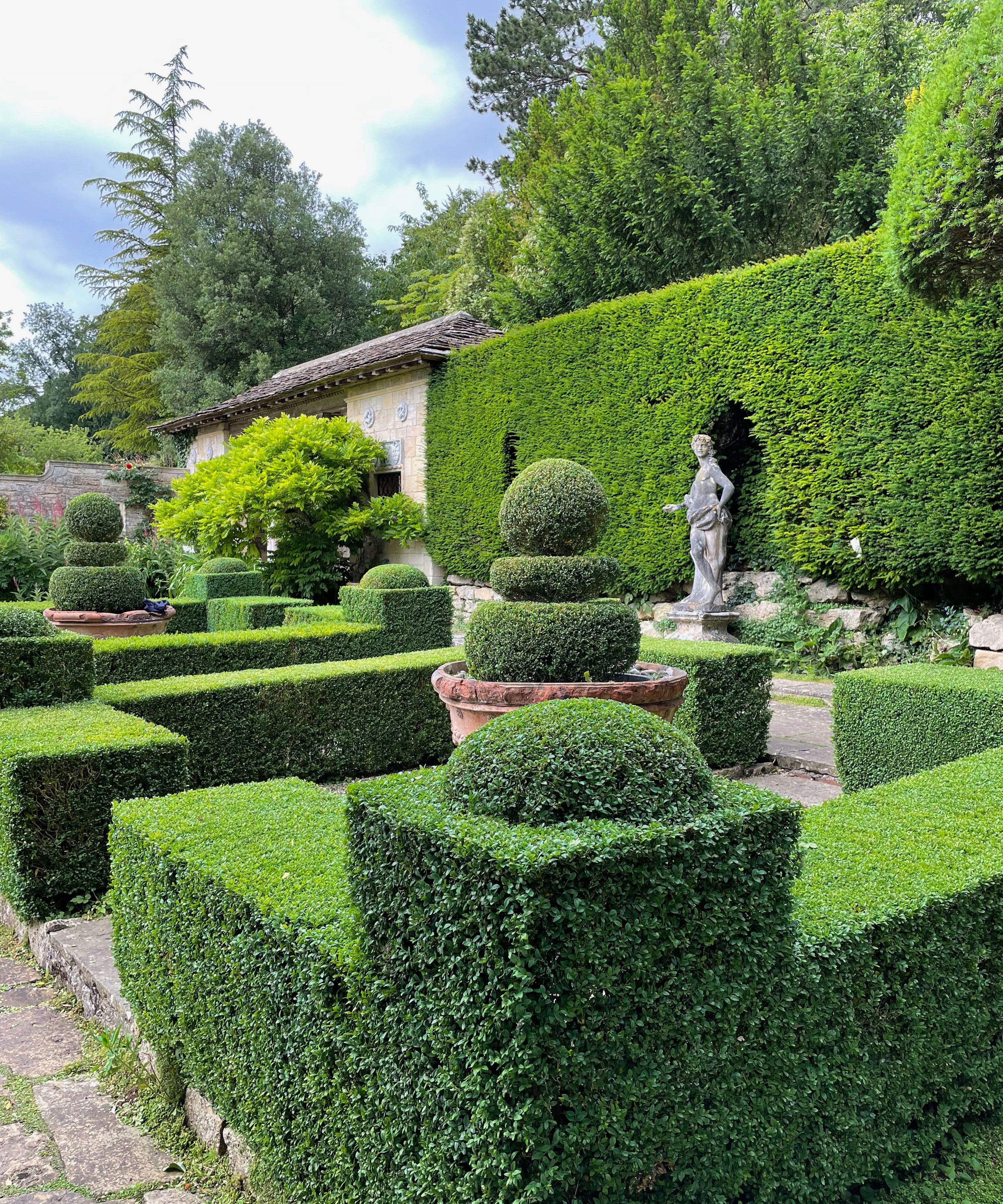
Although not the most obvious plant to include when planning a fall garden, evergreen shrubs and trees play a huge part in elevating other seasonal stars – often providing a dense and dark toned backdrop for these fall divas to shine against.
These plants are also useful for filling key gaps, disguising less-than-lovely outlooks or items such as AC units and generally for providing a backbone for the rest of the garden.
They also become particularly important during seasons of change – spring and fall – creating a constant garden framework to offset those plants emerging or slowly fading into dormancy.
Rainer Schubert, Managing Director at Burgon & Ball explains, ‘Evergreen shrubs are ideal for topiary, since they’ll keep their leaves in winter, providing the sought-after structure year-round. Native evergreen shrubs like yew, box and privet are classic choices.’
As with other trees and shrubs avoid planting during times of drought, flood or deep freeze.
Planting fall flowering bulbs

Planting bulbs in fall will bring you plenty of spring color, but plant bulbs in spring and you'll get fall color, too.
Perfect for adding jewel-like bursts of color to the fall garden, flowering bulbs can have a huge impact and transform borders, pots and grassy areas under trees. Often overlooked and less well known than spring flowering favorites, these September and October flowering beauties are worth getting to know.
Cyclamen, nerines, colchicums, starry Abyssinian gladioli and crocus lookalike sternbergia are best planted in clumps where they will make a striking impression. What’s even better, if they are happy in their new spot they will thrive and steadily multiply enhancing the effect year-after-year.
Planting bulbs does take some planning ahead. Fall flowering varieties need to be planted in spring – either in the ground or in pots where they can be popped into any gaps just before flowering.
What do you include in a fall garden?
There are stand out plants of every type that put on a spectacular show in fall, but don’t overlook the beauty ripe fruit and produce can provide.
Glowing squash, gourds and pumpkins will light up the veg patch, raised beds and weaving their way through herbaceous borders. Apples, pears, plums and damsons are jewel-like hanging from laden branches while the last of the tomatoes, corn, onions and beets add flashes of brilliant color.
Which plants will add impact to my yard for fall?
Garden chrysanthemums, sedums and crocosmia all bring vivid colour to the fall garden while late daisy type flowers such as asters, helenium, rudbeckia and sunflowers are also hard to beat.
However not all fall hero plants have showy blooms as Jonathan Pearce, Head Gardener of the Millennium Garden explains, ‘During fall, grasses really come into their own in glorious plumes of golden haze; these adding structure and contrast to the plants that surround them, and Echinacea turn a dark blackish color, making them stand out long through to winter, whilst the early frosts cling to the seed heads.’
When is it too late to plant a fall vegetable garden?
Successful planting crops later in the year really depends on your location and the date the first frosts arrive. The best way to check plant suitability is to check on your USDA hardiness zone – this guide is based on climate, average winter temperatures and indicates which plants are most likely to survive year-round.
Sign up to the Homes & Gardens newsletter
Design expertise in your inbox – from inspiring decorating ideas and beautiful celebrity homes to practical gardening advice and shopping round-ups.

Journalist Jill Morgan has spent over 20 years writing and editing gardening, interior and property features. Titles she has worked on include The English Home, House Beautiful, Ideal Home, Houzz and Modern Gardens and she writes regularly for H&G as a Contributing Editor. Whilst she is a dab hand at renovation projects and DIY, she is happiest when out digging in the garden or planning a new border.
-
 Urban gardening ideas – 7 creative ways to grow in small spaces, balconies, containers, indoors, and more
Urban gardening ideas – 7 creative ways to grow in small spaces, balconies, containers, indoors, and moreMake the most of your space with these innovative ways to garden
By Tenielle Jordison
-
 'Sexy disco-era Italy meets Japanese farmhouse in the Brazilian jungle' was the description the interior designer gave this glass-walled modernist home
'Sexy disco-era Italy meets Japanese farmhouse in the Brazilian jungle' was the description the interior designer gave this glass-walled modernist homeOffering a warm welcome that defies its stark, modernist lines, this archictectural gem is full of surprises
By Karen Darlow